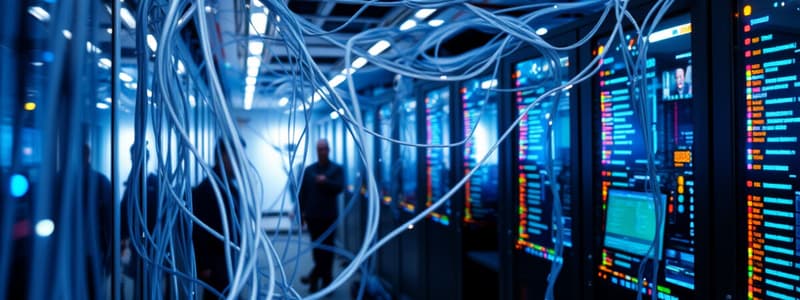Podcast
Questions and Answers
What is a characteristic of a Local Area Network (LAN)?
What is a characteristic of a Local Area Network (LAN)?
- Interconnects multiple cities
- Usually administered by multiple service providers
- Spans a large geographic area
- Provides high speed bandwidth (correct)
Wide Area Networks (WANs) are typically administered by a single organization.
Wide Area Networks (WANs) are typically administered by a single organization.
False (B)
What types of cables are used to interconnect WANs?
What types of cables are used to interconnect WANs?
Copper wires and fiber optic cables
A ____ is a worldwide collection of interconnected LANs and WANs.
A ____ is a worldwide collection of interconnected LANs and WANs.
Match the following types of networks with their characteristics:
Match the following types of networks with their characteristics:
What is one of the basic requirements of a reliable network?
What is one of the basic requirements of a reliable network?
The concept of a converged network refers to separate networks for voice, video, and data.
The concept of a converged network refers to separate networks for voice, video, and data.
What effect do networks have on how we interact, learn, work, and play?
What effect do networks have on how we interact, learn, work, and play?
The basic structure of the ______ consists of interconnected networks that communicate with one another.
The basic structure of the ______ consists of interconnected networks that communicate with one another.
Match the following terms with their correct descriptions:
Match the following terms with their correct descriptions:
What is an intranet primarily used for?
What is an intranet primarily used for?
An extranet allows users to access an organization's network from any location without authorization.
An extranet allows users to access an organization's network from any location without authorization.
Name one technology used for home internet connections.
Name one technology used for home internet connections.
An organization might use an __________ to provide secure access to their network for external individuals.
An organization might use an __________ to provide secure access to their network for external individuals.
Match the type of connection with its description:
Match the type of connection with its description:
Which of the following is NOT a service for connecting organizations to the Internet?
Which of the following is NOT a service for connecting organizations to the Internet?
DSL connections are typically slower than cable connections.
DSL connections are typically slower than cable connections.
What do organizations require faster internet connections for?
What do organizations require faster internet connections for?
The Internet is a large collection of __________ connected globally.
The Internet is a large collection of __________ connected globally.
Which service is especially designed for business-class interconnections?
Which service is especially designed for business-class interconnections?
Flashcards are hidden until you start studying
Study Notes
Chapter Overview
- Introduction of networking concepts including LANs, WANs, and the Internet.
- Importance of networks in everyday interactions, learning, working, and playing.
- Discussion of converged networks and their characteristics.
Globally Connected
- Technology has advanced dramatically in the last 20 years, reshaping daily life.
- The Internet serves as a foundational platform for numerous services and applications.
Types of Networks
- Local Area Network (LAN):
- Operates in a small geographic area, managed by a single entity.
- Offers high-speed bandwidth for connected devices.
- Wide Area Network (WAN):
- Connects multiple LANs over larger geographical areas, such as cities or countries.
- Usually managed by multiple service providers, providing slower speeds than LANs.
- Other types include Metropolitan Area Networks (MAN), Wireless LANs (WLAN), and Storage Area Networks (SAN).
The Internet
- A globally interconnected collection of LANs and WANs.
- Physical connections utilize copper wires, fiber optic cables, and wireless technologies.
- Governed by organizations like IETF, ICANN, and IAB for structural management.
Intranets and Extranets
- Intranet: A private network for internal organizational use, accessible only to authorized members.
- Extranet: Provides secure external access for partners needing to access an organization's network data.
Internet Connections
- Various technologies connect users to the Internet:
- Broadband cable and DSL are common for home users and small offices.
- Business connections support higher demands (IP phones, video conferencing) through dedicated services.
Converged Networks
- Converged networks integrate multiple communication services—data, voice, and video—over a single infrastructure.
- Simplifies management and reduces costs compared to managing separate networks for each service.
Reliable Network Architecture
- Network architecture encompasses the technology and design that facilitate data movement.
- Key characteristics:
- Fault Tolerance: Minimizes impact of failures across devices.
- Scalability: Supports growth without performance loss.
- Quality of Service (QoS): Ensures consistent performance and reliability.
- Security: Protects data integrity and user privacy.
Emerging Network Trends
- Smart Home Technology: Connects appliances for enhanced functionality, such as scheduling cooking times based on user calendars.
- Powerline Networking: Enables device connectivity through electrical outlets, bypassing the need for traditional cabling.
- Wireless Broadband: Expanding access in rural areas through Wireless Internet Service Providers (WISPs), utilizing cellular technology for internet connectivity.
Conclusion
- Understanding network types, connections, and the evolution of technology enhances preparedness for future networking challenges.
- Recognition of security needs and trends in network environments is critical for effective management.
Studying That Suits You
Use AI to generate personalized quizzes and flashcards to suit your learning preferences.




